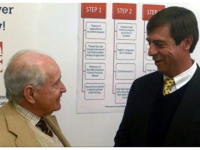Editor’s note: At AGC Houston’s 2014 Annual Chapter Meeting which was held in January, one of the featured guest speakers was Patrick Jankowski, Regional Economist and Vice President of Research for the Greater Houston Partnership (GHP). Following Ken Simonson’s presentation about the outlook for construction, Jankowski offered the following presentation about the Houston economy in general, which is published here with permission.I'm going to give you an outlook of what we see going on in the Houston economy in general. In 2014, Houston is going to enter the "New Normal."The chart below shows nonfarm payroll employment. This is what employment has done going back to January 2004. You see the peak that we reached in 2008, right around the time Hurricane Katrina hit. You can see the dip - the bottom of the recession for us is January 2010.
Reshaping the Construction Industry
Construction employment, spending hit highest levels since 2009; Beige Book is upbeatEditor’s note: Construction Citizen is proud to partner with AGC America to bring you AGC Chief Economist Ken Simonson's Data DIGest. Check back each week to get Ken's expert analysis of what's happening in our industry.Nonfarm payroll employment increased by 175,000, seasonally adjusted, in February and 2,158,000 (1.6%) over 12 months, the Bureau of Labor Statistics (BLS) reported on Friday. Construction employment rose by 15,000 for the month and 152,000 (2.6%) over the year to 5,941,000, the highest total since June 2009. Despite the gain in jobs, aggregate weekly hours fell year-over-year for the first time since April 2011 (-0.5%), indicating severe weather idled many workers. Residential construction employment (residential building and specialty trade contractors) climbed by 1,700 for the month and 101,200 (4.8%) for the year. Nonresidential employment (building, specialty trades, and heavy and civil engineering construction) rose by 12,700 from January and 50,600 (1.4%) year-over-year. All five residential and nonresidential segments added workers for the year. The unemployment rate for jobseekers who last worked in construction fell to the lowest February level in six years ...
March 10, 2014
One of our team pointed this article out to me and wondered whether you might like it. I think that it might expand your thinking about construction in the near future, so here goes.I admit to being intrigued by 3D printers, robots, drones, driverless cars and trucks, and even nano-scale/molecular scale robots for the delivery of meds that can save lives. The use of these technologies in construction will make a major impact over the next 5-10 years as labor shortages force their introduction to meet the demand of the projects of tomorrow. The use of robots in the rebuilding of structures after damage caused by natural disasters like typhoons, earthquakes, hurricanes or tornadoes adds another dimension in which they can make a difference.
March 07, 2014
Energized by the hiring of Executive Director, Chuck Gremillion, the Construction Career Collaborative (C3) Board and Committee Chairs met on February 6, 2014 at Marek Brothers Systems to establish their strategic goals for 2014. Gremillion, a highly-respected industry leader who had run the A&E Graphic Complex, his family’s business until it was sold, came on board on February 1, 2014. He took over from Katrina Kersch, a loaned Marek executive.The group established three specific goals:
March 06, 2014
The following is a blog written by a student at John Jay Science and Engineering Academy in San Antonio, who took part in the ACE (Architecture, Construction, and Engineering) Mentor Program, which mentors and inspires high school students to pursue careers in design and construction. Originally published on MarekBros.com.My name is Tristan Brown and during my junior year, I applied to a program called ACE (Architecture, Construction, and Engineering) Mentor Program. We worked with professionals in the fields expressed to complete the objective given. Our objective was to take an abandoned site and redesign it to benefit society by making a modern complex with diverse purposes to accommodate the people. I was assigned to the Architecture team which consisted of all seniors except for me. Our job was to make possible designs for what the new site would look like, decide on the locations of the criteria we had to meet, and design how the buildings were going to appear. Other teams included the Construction team and the Mechanical, Electric and Plumbing (MEP) engineering team. We met every other week during the Fall then the meetings increased in frequency during the Spring. The mentors along with our academic advisor, Mr. Rivera, gave us much insight in the fields and really helped me secure my decision in pursuing architecture.
March 05, 2014
There is an Equal Employment Opportunity Commission (EEOC) court case moving through the legal system that potentially could have major impact on every building site, general contractor and subcontractor in the country. It concerns the “Joint Employer” concept and Discrimination under Title VII. It is a case that you should have your legal teams and insurers watch closely over the next few months until it is fully resolved.
March 04, 2014
Starts tumble in January, MHC and Reed say; IIR sees double-digit industrial project riseEditor’s note: Construction Citizen is proud to partner with AGC America to bring you AGC Chief Economist Ken Simonson's Data DIGest. Check back each week to get Ken's expert analysis of what's happening in our industry.The value of new construction starts (including residential) tumbled 13%, seasonally adjusted, in January 2014 from December 2013 and 5%, not seasonally adjusted, from January 2013, McGraw Hill Construction (MHC) reported on February 21, based on data it collected. There were “moderate declines reported for nonresidential building [-6% for the month and year-over-year] and housing [-2% for the month, +8% year-over-year], as well as a more substantial loss of momentum [–32% for the month, -19% year-over-year] for nonbuilding construction (public works and electric utilities) after a particularly robust December…
March 03, 2014
“It’s a ‘which comes first: the chicken or the egg’ issue.” That is how Pete Dawson, Senior Vice President of Facilities Services for Texas Children’s Hospital, expressed his thoughts as an owner working to advance the principles of the Construction Career Collaborative (C3). The dilemma for the owner, according to Mr. Dawson, is accepting the need to pay more now for a skilled workforce that will only be available in the future. However, most agree that the young men and women who decide to forego college are not likely to choose an industry that might have a job for them, but not a career.Mr. Dawson said he certainly understands the owner’s concern about higher costs with minimal short-term results. But he added, “I tell them to think about the cost to your project five to ten years from now due to the low productivity and missed schedules of an untrained workforce.
March 01, 2014
Hi there. The Chamberlin Man here.Cupid just launched his arrows and the leprechaun will follow closely behind. Good thing we have these fellas to remind us of the season because Mother Nature seems a bit discombobulated lately.One day we're literally freezing and the next it's a sunny 70. We've gone from ice skating along our highways to rain boots in a matter of a few hours. The ever-changing temperature has been wreaking havoc on our lives of late. Less visibly apparent, but a challenge all the same, is the pressure this crazy weather is having on our roofing and building envelope systems.
February 27, 2014
Originally posted by Katrina Kersch on MarekBros.com.As our workforce program has grown in depth, scope and experience, I would like to pause and reflect on what workforce development looks like versus conducting training programs. As our team takes on career paths development opportunities for our professional employees, the WFD team (Workforce Development) will be looking to incorporate standards that exist beyond the training experience and into developing a winning team for our organization.In writing this blog, I intended to outline this difference between training and workforce development, but then I found an excellent article titled Workforce Development is More Than Just Training by Dick Grimes which says it perfectly. Please read the entire article. Some but not all of my favorite points include the following.Workforce development in its best sense includes:Before sending employees to a class, we require leaders to tell us first how they will work with the employee to reinforce the application of it AFTER the training event because we know that training without reinforcement is a waste of resources.
February 27, 2014



.jpeg?itok=6uFZXEBH)





.jpeg?itok=4Vi_1nJG)
































